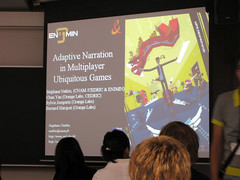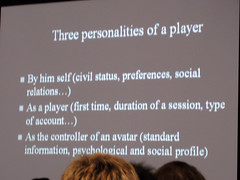Stéphane Natkin, Chen Yan, Sylvie Jumpertz, and Bernard Marquet:
Creating Multiplayer Ubiquitous Games using an adaptive narration model based on a user's model
It was interesting to see the progress of this work that I found to bee one of the highlights of the ACE2006 Conference. They have kept the three layered narration structure as presented a year ago, but this presentation focussed on the user model, which also was presented in a three layered model. Dividing things in three seem to be a meta-narrative of this interesting research project.
Freeform notes I threw down while listening:
The designer thinking of the implied player.
On the three personalities of a player,
Good idea to divide it into layers (3).
Using 5 factor model, based on Myers Briggs
Instantiation of quest according to the player’s current state. Adaptation of the player model according to the chosen quest.
Short video of a racing game, built at the university. Wheelchair race.
Needed budget, 50 – 100players playing 2 weeks, give them clients etc,
QA
Staffan B: Single player?
AN: It is multiplayer. Assign roles to each other. But this doesn’t work in ubiquitous games due to RL obligations. Instead have alternate ways to complete the quests. 15 possible quests that can be assigned to each player.
Q: why do you call it a narrative structure rather than functional?
SN: Narrative as a series of quests. More complex sequences. Level design in the real city.
Q: we are building an ubiquitous game with a feedback loop for actions. If I understand right you have an avatar. We use the god model instead. The general purpose model tends to be generic. In our games we need specific information about what the player is doing RL, is he brushing his teeth… sitting on a char?
SN: There is an individualization of each player. It is between having an avatar and playing a role. On the second point. It is difficult to adapt a design for all different real world situations. Depends on actuators and actors. Difficult to have a model that fit every game.

